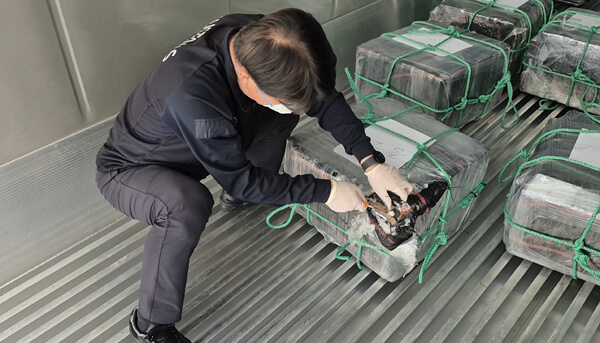Portugal’s Judicial Police seized more than 1.5 metric tons of cocaine, which they believe was part of a larger smuggling ring using animal hides to obscure the drugs. It is the latest in a series of large drug seizures as police report they believe the cartels continue to expand their efforts to evade detection.
Rotting Hides in Portugal
Acting on a tip from the U.S. Drug Enforcement Agency and Customs and Border Protection, the police at the Port of Leixoes were asked to investigate an incoming container. The police were targeting an import company that had brought three containers of animal hides into Portugal.
Inspecting the container, the police reported they found a large quantity of cocaine hidden between the animal skins. The police said the raw hides had been loaded two weeks earlier in Latin America, but by the time they reached Portugal, they were putrid, and the stench made the investigation more difficult.
Monitoring the container, the police reported it was claimed and driven to a warehouse near Fafe, where the arrests were made. Two men were taken into custody, including a former police officer who was currently on long-term leave, off active duty. They also seized firearms, vehicles, and motorcycles, as well as other evidence.
The seizure was considered to be another example of the widening efforts of the drug cartels to ship cocaine. The police believe the cartels are resorting to new methods and routes to move their merchandise.

Police investigating the contents of a container in Busan (Busan Regional Customs)
Busan, South Korea’s Largest Seizure
Korean authorities confirmed this, detailing a May seizure which was the largest ever at the Busan New Port and the second largest ever in Korea. Details of their three-month investigation found that it may have been a misdirected container or scheduled for transshipment with no connection to Korea. The search found 600 kg of cocaine with a street value of $216 million.
Again, acting on a tip from the U.S. authorities, the police seized a container arriving at Busan New Port on May 10. They reported that an analysis showed the container was loaded on a different vessel than suspected and retrieved before an unnamed containership could depart port. The container was loaded in Central or South America, and the vessel made a stop in Japan before Korea and was bound for China.
The police questioned the 27 crewmembers, 5 Greeks and 22 Filipinos, and searched their cell phones. They were satisfied that the crew was not involved in drug smuggling and unaware of the contents of the container. They also were able to obtain 137 fingerprints off the 12 waterproof packages, which each had 50 1 kg blocks of cocaine, as well as from the interior of the container. Furthermore, they searched the 90,000-ton vessel, including an underwater survey.
The police believe the container was not retrieved and “for unknown reasons, it ended up at Busan New Port without being recovered.” They did not find a GPS tracking device in the container.
It was the second large seizure in South Korea in 2025. In April, the police confiscated 1,700 kg of cocaine at Okgye Port. The police report a continuous, but growing flow of drugs being detected. In 2021, they detected 400 kg of cocaine in a container with avocados, 33 kg in a refrigerated container in 2024, and 100 kg in the sea chest on a ship.